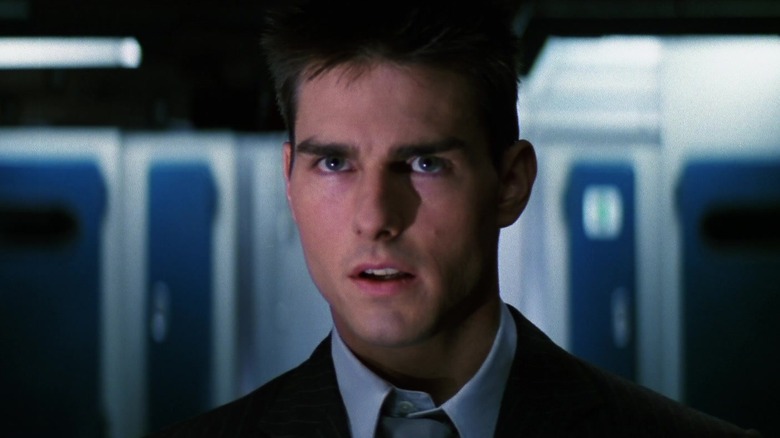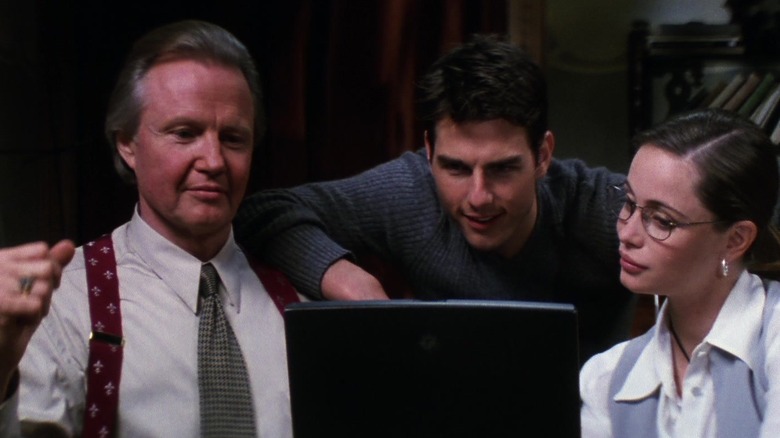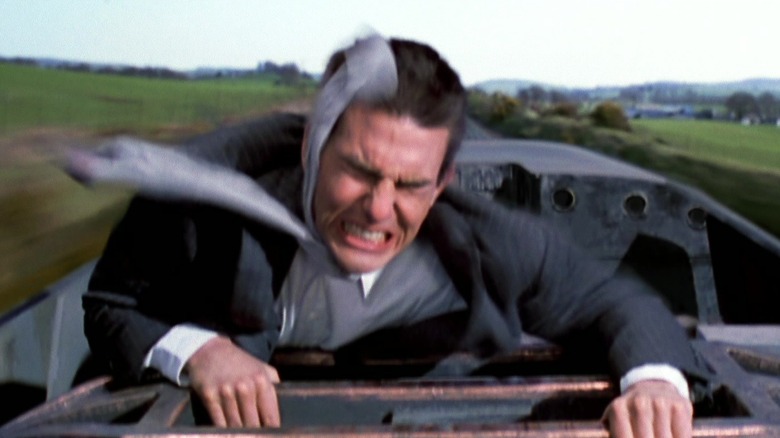Why The Cast Of The Mission: Impossible TV Show Hated The Original Movie
Nearly 30 years after the release of the 1996 "Mission: Impossible" movie, most people assume the Brian De Palma film was a big success. There's the fact that it grossed over $450 million worldwide at the box office, in addition to earning solid reviews from critics. And any movie that spawns a franchise spanning four decades has to be special. The potentially final and, notably, longest entry, "Mission: Impossible — The Final Reckoning," has leaned hard into referencing earlier films in the series with its pre-release marketing campaign, especially quintessential moments like Impossible Missions Force (IMF) agent Ethan Hunt (Tom Cruise) not only dangling from a wire in a highly pressurized and sensitive CIA location but also wielding a knife that plays a crucial part in that set piece.
Yet, there's one aspect of the 1996 film that, as critical as it is to the movie series' entire reason for being, is easy to forget was particularly daring if you're not of a certain age. Though it's since come to feel like Cruise's attempt to refashion himself as an American James Bond, the "Mission: Impossible" property started out as a well-liked and successful TV show in the 1960s — one that was popular enough to get a late-1980s small-screen revival. When De Palma's "Mission: Impossible" arrived in movie theaters, people may have anticipated a new Cruise picture but had some hesitation since the film was based on a TV show. In fact, the movie was so different from the "Mission: Impossible" TV series that the cast of the latter absolutely loathed the former and wasn't shy about telling people for two big reasons: It made the show's hero into a villain and totally blew up the premise of the TV program to focus on a singular hero.
The original Mission: Impossible movie's setup alienated the TV show's cast
Some of the broad strokes of the "Mission: Impossible" TV series, which ran for seven seasons from 1966 to 1973, are present not only in the 1996 film but also its sequels. Both feature a version of the IMF that executes challenging missions that require people to fill different roles, such as handler, tech expert, and so on. Said missions are also laid out by an offscreen voice that ends by saying the message will self-destruct in seconds. But while the "Mission: Impossible" TV show had key agents (played by actors like Martin Landau, Leonard Nimoy, and Lesley Ann Warren), it did not feature Ethan Hunt, who was created for the films.
Another critical similarity between the two is Jim Phelps, played in the show by Peter Graves and the 1996 film by Jon Voight. In the show, Jim was the reliable leader of the IMF starting in the show's second season (and continuing in the revival, which aired from 1988 to 1990). But in De Palma's movie, Jim's entire IMF team is killed in the first act, save for Ethan. By the end, we learn Jims actually masterminded the massacre. As shocking as this may have been to audiences, it was almost infuriating to the TV series' cast.
At the time, Grave simply remarked, "I am sorry that they chose to call him Phelps" (via The Guardian). He (reasonably) added that the film's premise could have been exactly the same without calling Voight's character Jim Phelps:
"They could have solved that very easily by either having me in a scene in the very beginning, or reading a telegram from me saying, 'Hey boys, I'm retired, gone to Hawaii.'"
Greg Morris, who played one of the show's tech experts, had an even harsher assessment. When he passed away just a few months after the film's release in August 1996, the Los Angeles Times reported he had walked out 40 minutes into a screening of De Palma's movie (declaring it an "abomination").
Speaking to MTV News in 2009, Landau similarly rejected the idea of reprising his character from the TV show, Rollin Hand, in the "Mission: Impossible" movies. He also noted that an earlier version of the 1996 film's script went further than the eventual movie did, explaining, "They wanted the entire team to be destroyed, done away with one at a time, and I was against that." Perhaps the only key difference in the finished film is that Ethan's fellow IMF agents don't share the names of characters from the TV series.
Later Mission: Impossible films (wisely) moved away from their TV inspiration
Although the "Mission: Impossible" film series still retains a few of the aspects of the TV show from which it was inspired (let's not forget the undeniably catchy Lalo Schifrin theme song, which still finds its way into the scores of each movie), it has happily and firmly moved away from its source material in almost every way possible. Even when you think about the jaw-dropping CIA break-in sequence from the first "Mission: Impossible" film, it's almost hard to square that movie's tense 110 minutes with the outrageous and delightfully gargantuan stunt-work that we now associate with the franchise. De Palma's film may end with a sequence in which Ethan and his old boss-turned-enemy fight each other atop a fast-moving train (while the visual effects hold up relatively well, Cruise and Voight aren't doing this for real), it doesn't really compare to Cruise really, truly hanging onto moving planes in the sequels.
When De Palma's "Mission: Impossible" released in theaters, it was as big a swing for Cruise — who was trying to establish himself as a major action hero — as it was for the franchise, which risked alienating audiences who may have expected something a bit truer to the '60s TV show. Cruise couldn't have made too many friends among the series' cast, especially since his version of the IMF was focused on Ethan and very few other people. But while the "Mission: Impossible" movies may not have won over anyone from the show, it has since become such a mammoth global hit that younger generations might be more shocked to learn Ethan's adventures not only started on the small screen but didn't actually involve Ethan at all.


